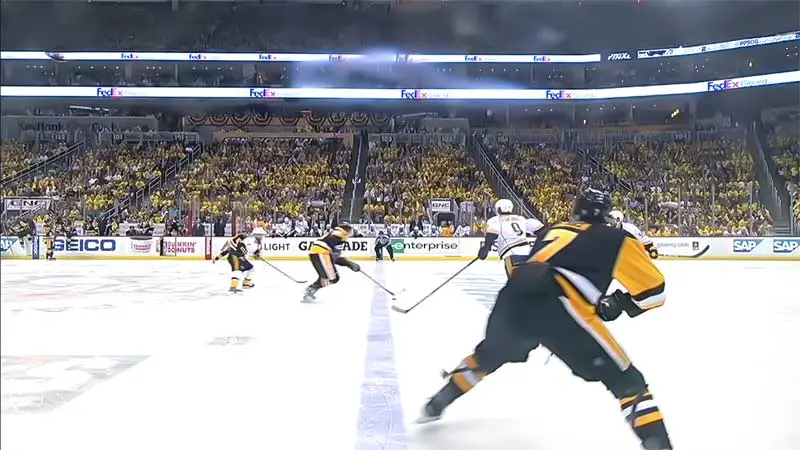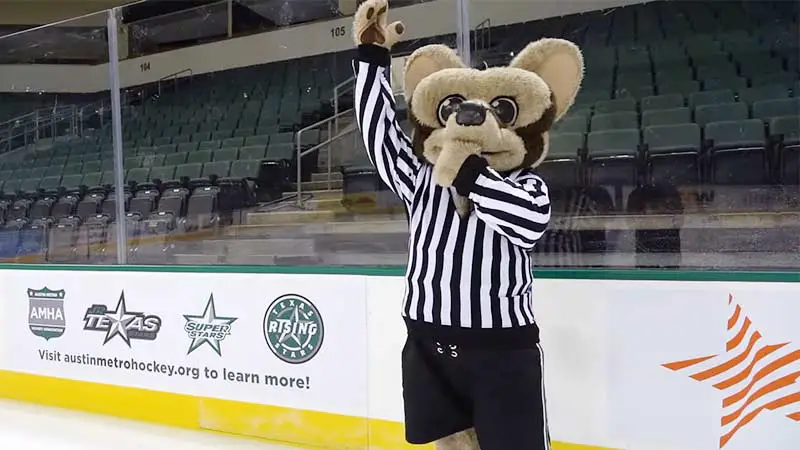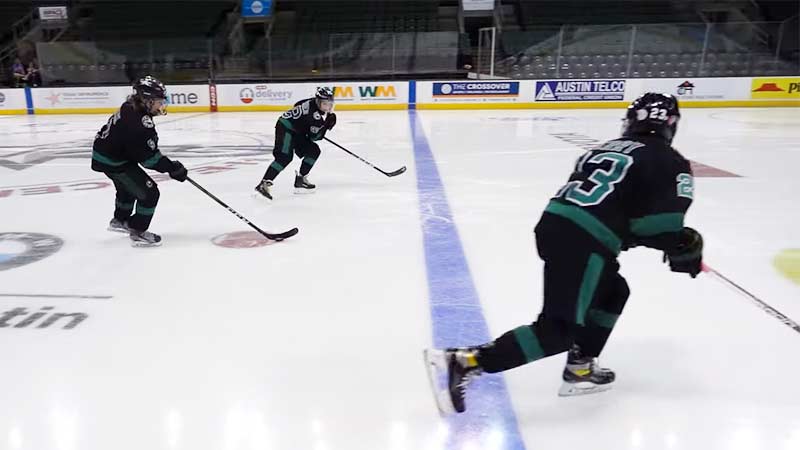In the fast-paced world of hockey, understanding the nuances of its rules is essential for players and fans alike. One pivotal aspect that often dictates the flow of the game is the concept of “offsides.”
This rule, designed to maintain fairness and prevent undue advantages, involves the strategic positioning of players relative to the puck.
In this blog post, we delve into the intricacies of what is off-side in hockey, exploring its definition, variations, and impact on gameplay.
From the role of linesmen in making split-second decisions to the evolution of off-side rules across different leagues, we aim to provide a comprehensive understanding of this fundamental element in hockey. So, stay focused.
What Is Off Sides in Hockey?
Offside in hockey is a fundamental rule designed to maintain fairness and structure in the game. It occurs when an attacking player crosses the opposing team’s blue line into the offensive zone before the puck does.
This rule aims to prevent players from gaining an unfair advantage by positioning themselves closer to the opponent’s goal.
In the past, the two-line pass rule restricted passes across both the defensive blue line and the center ice red line, but this has largely been eliminated to encourage more dynamic offensive plays.
The tag-up offside rule allows a player to re-enter the offensive zone after clearing the blue line and touching the neutral zone, reducing stoppages.
Additionally, the delayed offside concept allows offending players to rectify their position before play is halted.
Exceptions exist, such as when the puck is played by the goalkeeper, showcasing the nuanced nature of offside regulations in hockey.
Basics of the Off-Sides in Hockey

Understanding the basics of offside in hockey is crucial for both players and fans, as it plays a pivotal role in the flow and fairness of the game.
Offside violations can result in stoppages and penalties, impacting the dynamics of play. Here are some key points to grasp the fundamentals of offside in hockey:
Definition of Offside
Offside in hockey occurs when an attacking player precedes the puck into the offensive zone before it crosses the blue line.
The blue line serves as the boundary between the neutral zone and the offensive zone. Players must ensure they do not cross this line ahead of the puck, maintaining the integrity of fair play.
Two-Line Pass Rule
Historically, the two-line pass rule was in effect, restricting passes across both the blue line in the defensive zone and the red line at center ice.
However, this rule has been eliminated in many hockey leagues, allowing for more fluid offensive plays.
Understanding this change is essential, as it alters how players approach offensive strategies and breakouts.
Tag-Up Offside
To prevent constant stoppages and interruptions in the game, the tag-up offside rule was introduced.
This rule allows an attacking player to re-enter the offensive zone after clearing the blue line and touching the neutral zone.
This eliminates the offside violation, provided no other attacking player remains in the offensive zone ahead of the puck.
Delayed Offside
In cases where an attacking player is in the offensive zone ahead of the puck, the linesman may not blow the whistle immediately.
Instead, the linesman signals a delayed offside by raising their arm, allowing the offending player to exit the zone.
If the player does not comply and touches the puck while still offside, the linesman will stop the play, enforcing the offside violation.
Exception for the Goalkeeper
A unique aspect of offside in hockey involves the goalkeeper.
If the puck is passed or shot into the offensive zone and a teammate is offside, the linesman may not whistle the play dead if the puck first touches or is played by the goalkeeper.
This exception acknowledges the goalkeeper’s role in controlling play and allows for more strategic offensive maneuvers.
Understanding the intricacies of offside in hockey enhances the overall experience for players and fans alike, contributing to a fair and exciting game.
How Offsides is Called in Hockey

Understanding how offsides are called in hockey is crucial for players, officials, and fans alike. The enforcement of offsides ensures fair and competitive gameplay.
Here are some of the key points detailing the process of how offsides is called in hockey:
Linesman’s Decision
Offsides are primarily determined by the linesmen, who are positioned along the blue lines. They visually assess whether attacking players have crossed the blue line into the offensive zone ahead of the puck.
Linesmen must make split-second decisions, and their expertise is vital in maintaining the integrity of the game.
Positioning and Timing
Linesmen use their positioning and timing to accurately judge offsides. They often skate backward along the blue line, keeping a close eye on the puck’s movement and the position of players.
Their ability to anticipate plays and quickly identify infractions is crucial in making precise calls.
Delayed Offside Protocol
When an offsides situation arises, linesmen signal a delayed offside by raising their arms. This allows the attacking players to exit the offensive zone and re-establish themselves onside.
If the players fail to comply and touch the puck while still offside, the linesman stops play, and a faceoff occurs outside the offensive zone.
Video Review Challenges
In some leagues, coaches have the option to challenge off-side calls through video review. This process involves examining the footage to determine if the linesmen’s decision was accurate.
Video review adds an additional layer of scrutiny to critical off-side situations, helping ensure the right calls are made, though it’s not universally adopted in all hockey leagues.
Goalkeeper’s Role
A unique aspect of offsides involves the goalkeeper. If the puck is played into the offensive zone and is touched or played by the goalkeeper, the linesman may choose not to whistle for offsides.
This exception recognizes the goalkeeper’s influence in controlling play and contributes to the flow of the game.
Understanding how offsides is called enhances appreciation for the precision and expertise required by officials, contributing to the overall fairness and excitement of hockey.
Hockey Offsides Rule Variations
While the fundamental concept of offsides remains consistent in hockey, there are variations in the rules across different leagues and levels of play.
These variations add nuance to the application of the offsides rule, influencing gameplay and strategic considerations. Here are some key points highlighting some variations in the hockey offsides rule:
Tag-Up Offside vs. Immediate Whistle
One notable variation involves the decision to either implement the tag-up offside rule or immediately whistle the play dead.
In some leagues, an offside player can “tag up” by exiting the offensive zone and re-entering, eliminating the offsides infraction if no other attacking player touches the puck in the meantime.
However, other leagues may choose to whistle the play dead immediately upon detecting an offside violation.
Video Review Challenges
Certain hockey leagues have introduced video review challenges for offside calls. Coaches can contest the linesmen’s decisions by requesting a review, allowing officials to scrutinize the play using video footage.
This additional layer of review helps ensure the accuracy of crucial offside calls and provides teams with the opportunity to challenge potentially game-changing decisions.
Blue Line Technology
In some elite-level competitions, such as international tournaments or professional leagues, advanced technology may be used to assist officials in making offside calls.
Sensors or cameras embedded in the ice or around the rink can provide real-time data to confirm or overturn on-ice rulings, reducing the margin of error in determining whether a player has crossed the blue line ahead of the puck.
Zero Tolerance for Offsides
Some leagues adopt a zero-tolerance policy for offsides, emphasizing strict enforcement of the rule to maintain the pace and integrity of the game.
This approach minimizes the gray areas and ensures that even marginal infractions are penalized, preventing teams from gaining an unfair advantage through strategic positioning.
Modified Offsides for Youth Hockey
In youth hockey, especially at the beginner levels, modified offside rules may be in place to encourage skill development and participation.
Some leagues implement variations like the “no-touch” offsides rule, where players are allowed to enter the offensive zone before the puck, but they must “touch up” by exiting the zone completely before re-engaging in the play.
Understanding these variations in hockey offside rules is essential for players, coaches, and fans, as they contribute to the unique dynamics and strategies within different hockey leagues and levels of competition.
Strategies to Avoid Offsides in Hockey
Avoiding offsides is a crucial aspect of strategic play in hockey, ensuring teams maintain possession and create scoring opportunities.
Implementing effective strategies to stay onside requires coordination and awareness on the part of players. Here are some key strategies to help teams minimize offsides in hockey:
Blue Line Timing and Positioning
Players must develop a keen sense of timing and positioning when approaching the offensive blue line. Anticipating the puck’s movement and ensuring that teammates are not ahead of it is essential.
By maintaining proper spacing and coordinating their movements, players can enter the offensive zone in sync with the puck, reducing the risk of offsides.
Communication Among Teammates
Clear communication is paramount in preventing offsides. Players should consistently communicate their positions on the ice, especially when approaching the blue line.
Verbal cues or non-verbal signals help teammates coordinate their movements, allowing for seamless entries into the offensive zone.
Effective communication enhances overall team cohesion and minimizes the chances of inadvertent offsides.
Neutral Zone Transition
Teams can strategically manage their transitions through the neutral zone to minimize offsides. Controlled entries, where players carry or pass the puck with purpose, provide better visibility and coordination.
Avoiding rushed or chaotic plays in the neutral zone reduces the likelihood of players inadvertently crossing the blue line ahead of the puck, contributing to a smoother offensive flow.
Practice and Drill Execution
Regular practice and drills focusing on offensive zone entries are essential for developing the skills needed to avoid offsides.
Coaches can design specific exercises that simulate game situations, emphasizing proper timing, positioning, and coordination.
Repetition of these drills helps players refine their instincts and become more adept at navigating the blue line during actual gameplay.
Awareness of Opponents’ Defensive Strategies
Teams should be aware of the defensive strategies employed by their opponents, as these can influence offensive zone entries.
Recognizing defensive formations and adjusting offensive approaches accordingly can help teams anticipate and counter potential challenges, reducing the risk of offsides.
Being adaptable and strategic in response to the opposing team’s tactics is key to maintaining offensive momentum.
Implementing these strategies collectively enhances a team’s ability to enter the offensive zone effectively while minimizing offsides.
FAQs
What is offside in hockey?
Offside in hockey occurs when an attacking player enters the offensive zone before the puck crosses the blue line.
This rule prevents players from gaining an unfair advantage and maintains the integrity of fair play.
How is offside determined?
Offside is determined by linesmen, who visually assess whether attacking players precede the puck into the offensive zone.
Their positioning and timing are crucial in making accurate split-second decisions.
Are there variations in offside rules?
Yes, offside rules vary among leagues. Some leagues employ the tag-up offside rule, while others may use video review challenges.
Blue line technology and zero-tolerance policies also contribute to rule variations.
Can a player re-enter the offensive zone after going offside?
Yes, with the tag-up offside rule, a player can re-enter the offensive zone after exiting and touching the neutral zone. This prevents constant stoppages and allows players to rectify their position.
How does offside affect goalkeepers?
If the puck is played into the offensive zone and touched or played by the goalkeeper, the linesman may choose not to whistle for offside.
This acknowledges the goalkeeper’s role in controlling play and allows for strategic offensive maneuvers.
Wrapping Up
In the fast-paced and dynamic realm of hockey, the offsides rule stands as a guardian of fair play, ensuring that the game unfolds with precision and strategy.
From the determination of linesmen to the varied league-specific adaptations, grasping the concept of offsides enhances the overall appreciation of this exhilarating sport.
As players navigate the blue lines with strategic finesse and fans cheer for well-executed offensive plays, the importance of offsides becomes clear.
With its impact on gameplay and the constant evolution of rules, offsides adds depth to the hockey experience, making every match a thrilling display of skill and adherence to the sport’s fundamental principles.
So, next time you’re on the edge of your seat during a hockey match, take a moment to appreciate the subtle dance between players and the blue lines, where the concept of offsides comes to life. Thank you so much.








James Felix